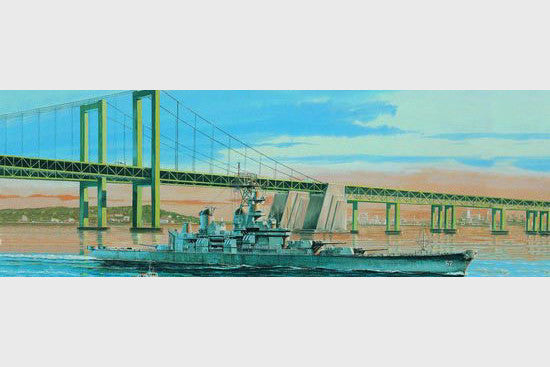
The construction of BB-61 Iowa began on 16 September 1940 in the New York Navy Yard. as the first Ship of Iowa class battleships. The Iowa class was Planned with a view to rival the super battleships. (Yamato class-to-be) planned by Japan, which withdrew from Washington and London Treaty in 1936. According to its design, the Iowa class was 45,000 tons (the very limit to the London Treaty), nine 16in/50cal guns in three batteries, and speed 33 knots. The speed was decided under precautions against the Japanese Knots class battleships, which boasted of speed 30 knots. To fulfill those conditions, its engine compartment for a high-power engine needed to be large. However, the width of US warships Was limited to 33m. Because the US faced two oceans and its ships had to pass through the Panama Canal. Inevitably, the waterline of the Iowa class was as long as 262m. Iowa entered service on 22 February 1943 and experienced several battles in the Pacific Ocean with New Jersey, her sister Ship. The next year she participated in Battle of Leyte Gulf. Then she and New Jersey Were expected to confront with Adm. Kurita’s freet inchlding Yamato and Musashi. It was, however, not realized because of Adm. Ozawa’s decoy operation and Kurita’s mysterious U-turn. In April 1945 Iowa, which had been repaired in the US, returned to the Battle of Okinawa and supported landing attacks with her bombardment. Against it the Japanese Navy ordered Yamato and 9 warships to Okinawa. On the way Yamato was sunk by aerial attacks by US aircraft carriers. After all the fight of the super battleships between the US and Japan was forever unrealized. By the way the comparison between Iowa and Yamato is often treated in some technical books. Certainly Yamato (18in guns, 41cm armor) exceeds Iowa (16in guns, 31cm armor) in gunnery and armor. However, Iowa is faster by 6 knots and discharges more shells in one minute than Yamato. And Yamato’s 15m rangefinders gave tremendous precision, but was no match for Iowa’s radars. All these conditions considered, it is difficult to decide which is better. In a night battle, Yamato could have been one-sidedly hit by Iowa. Moreover, the supremacy of naval force had been switched from battleships to aircrafts when the two were constructed. From that point of view, Iowa was more powerful I that she served as the escort of aircraft carriers. The outbreak of the Korean War in June 1950 brought back Iowa, which had been I mothballs after the WW ,TO THE BATTLEFIELD. IN April 1952 she succeeded the flagship of the 7th Fleet from New Jersey and was active in the neiboring waters of Korea. After the cease-fire she was again in mothballs. In 1980 Reagan Administration ordered the revival of Iowa class battleships under the project of deference buildup of US naval force. Iowa was modernized and re-entered service in March 1984 with Harpoon, Tomahawk, and cutting-edge electric devices. She went to European waters I the middle of 1980s, and was also active in the Indian ocean and Arabian Sea. As the Cold War ended, the Iowa class ships were finally deleted from the Navy list. Iowa is now in Benicia, California as a memorial ship.
